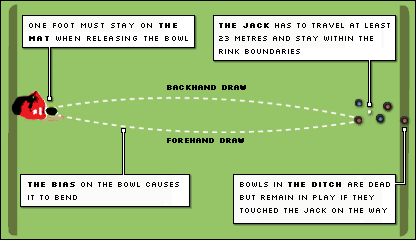Beginner's guide to Bowls
Lawn Bowling- A Complete Beginners' Guide
The aim of the game is simple. Get your bowls as close as possible to a small white ball called the ‘jack’.
It might sound easy, but the fact that the bowls do not travel in a straight line seriously adds to the tactical challenge.
Bowls can be played indoors or outdoors, and the rules are the same.
HOW COMPETITIONS UNFOLD
All the action takes place on a standard bowling green, which is a flat square 34-40m long. This is divided into six playing areas called rinks.
After a coin toss, the first bowler (the lead) places the mat and rolls the jack to the other end of the green as a target.
The jack must travel at least 23m and, when it comes to rest, it is moved across to the centre of the rink.
The players then take turns to bowl.
When all the bowls have been played, a competitor or team gets one point for each of their bowls that is closer to the jack than the opponent’s closest bowl.
After all the bowls have been delivered, the direction of play is reversed. This is the end of an end!
Bowls can be played in singles, pairs, triples and four-player teams (sometimes known as rinks).
Each player has four bowls per end in singles and pairs competitions, three in triples, and two in fours.
The team captain, or ‘skip’, always plays last and is instrumental in directing the team’s shots and tactics.
HOW THE SCORING WORKS
Scoring systems vary for different competitions.
However, it is usually the first player to reach 21 points, or the highest scorer after 18 or 21 ends.
TYPES OF DELIVERY
The bowls are not quite round. They are shaved on one side which gives them the bias.
As the bowl slows, it begins to roll in the direction of the bias.
Bowlers will therefore change the side of the bias, depending on the direction in which they want the bowl to curve.
The challenge of all shots is to be able to adjust line and length accordingly.
The faster the delivery, the smaller the curve.
Draw shot: This allows the bowler to roll the bowl to a specific location without disturbing the other bowls too much.
For a right-handed bowler, ‘forehand draw’ is initially aimed to the right of the jack, and curves in to the left.
The same bowler can deliver a ‘backhand draw’ by turning the bowl over in the hand and curving it the opposite way, from left to right. In both cases, the bowl is usually rolled as close to the jack as possible.
The drive: Involves bowling with considerable force with the aim of knocking either the jack or a specific bowl out of play. There is very little curve on this shot.
Upshot or yard on: Involves delivering the bowl with enough power to move the jack or disturb other bowls, but without killing the end.
DITCH RULES
Bowls reaching the ditch are removed from play.
However, if they touch the jack before heading into the ditch they remain ‘alive’ and in play.
If the jack is knocked into the ditch it remains ‘alive’ unless it is out of bounds to the side of the rink.
This is called a ‘dead’ end and is replayed.
TACTICS
There can be a large number of bowls on the green towards the conclusion of an end – particularly in the team games – and this gives rise to some complex tactics.
For example, the team with the closest bowl will probably decide not to aim for being close to the jack.
It is probably in their interest to opt for a more blocking shot by setting their bowls up to make it difficult for opponents to get their bowls in towards the jack.
This area is called ‘the head’.
Or players will try to get their bowls in places where the jack might be deflected to if the opponent attempts to disturb the head.
THE BOWLS
Jack: 6.35cm diameter Woods: 12-13cm diameter 1.25-1.6kg
Made of a hard plastic composite material
You can play all year round – indoor bowls in the winter and out on the greens in the summer.
